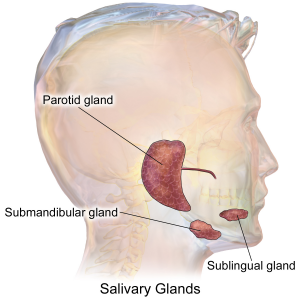
Physiology
Gastrointestinal
At rest, saliva is produced predominantly by which of the following:
Answer:
At rest, most saliva is produced by the submandibular gland (65%). When stimulated by the autonomic nervous system, about 50% of saliva is produced by the parotid gland with only 30% produced by the submandibular gland.Saliva
Physiology / Gastrointestinal / Mouth and Oesophagus
Last Updated: 21st May 2025
Sites of Production
Three main pairs of glands: the parotid, submandibular and sublingual glands secrete saliva. About 1 - 2 L of saliva is produced per day, and almost all is swallowed and absorbed.
| Salivary gland | Contribution at rest | Contribution when stimulated |
|---|---|---|
| Parotid gland | 20% | 50% |
| Submandibular gland | 65% | 30% |
| Sublingual gland | 7-8% | 10% |
| Minor glands | 7-8% | 10% |

Salivary Glands. (Image by Blausen.com staff (2014). "Medical gallery of Blausen Medical 2014". WikiJournal of Medicine 1 (2). DOI:10.15347/wjm/2014.010. ISSN 2002-4436. (Own work) [CC BY 3.0 , via Wikimedia Commons)
Composition
Saliva is hypotonic and alkaline, and contains a mixture of both inorganic and organic constituents. Saliva composition varies according to the rate and site of production, but the main components are:
- Water (99%)
- Mucus
- Digestive enzymes e.g. amylase, lingual lipase
- Antibacterial enzymes e.g. lysozyme
- Secretory immunoglobulins e.g. IgA
- Electrolytes (high K+ and HCO3- concentration)
Control of Secretion
Secretion of saliva is under the control of the autonomic nervous system. There is a baseline level of secretion (about 0.5 mL/min) due to ongoing low-level parasympathetic stimulation which prevents the mouth and pharynx from drying out. On top of the baseline, increases in salivary secretion can occur in response to food activating gustatory receptors or mastication activating mucosal mechanoreceptors or in response the sight, smell and anticipation of food. However salivation is initiated, the impulses to the salivary glands travel via the autonomic nerves.
The sympathetic control of salivary production is via the superior cervical ganglion. Sympathetic innervation causes increased protein secretion resulting in increased production of a thick mucoid saliva. There is variable sympathetic innervation between the salivary glands and generally this system is far less important than the parasympathetic innervation in terms of regulating production of saliva.
The parasympathetic outflow is coordinated via centres in the medulla, and parasympathetic innervation to the salivary glands occurs via the facial nerve (to the submandibular and sublingual glands) and the glossopharyngeal nerve (to the parotid gland). This results in the following effects: increased production of saliva by acinar cells, increased secretion of bicarbonate by ductal cells, increased blood flow to the salivary glands and contraction of myoepithelium to increase the rate of expulsion of saliva. Overall, increased parasympathetic stimulation results in an increased flow of saliva that is more watery in composition. Saliva production is decreased by inhibition of the parasympathetic nervous system e.g. by sleep, dehydration, anticholinergic drugs and fear.
Function
Functions of saliva in health include:
- General cleansing and protection of the buccal cavity by washing away food particles
- Moistening of the buccal cavity for speech
- Lubrication of ingested food for bolus formation and swallowing
- Dissolving of chemicals in food allowing them to interact more efficiently with taste buds
- Dilution and neutralisation of acid in food (and produced by bacteria)
- Secretion of digestive enzymes (particularly amylase for early starch digestion)
- Secretion of the antibacterial enzyme lysozyme
- Secretion of IgA to protect against invasion of microorganisms
Report A Problem
Is there something wrong with this question? Let us know and we’ll fix it as soon as possible.
Loading Form...
- Biochemistry
- Blood Gases
- Haematology
| Biochemistry | Normal Value |
|---|---|
| Sodium | 135 – 145 mmol/l |
| Potassium | 3.0 – 4.5 mmol/l |
| Urea | 2.5 – 7.5 mmol/l |
| Glucose | 3.5 – 5.0 mmol/l |
| Creatinine | 35 – 135 μmol/l |
| Alanine Aminotransferase (ALT) | 5 – 35 U/l |
| Gamma-glutamyl Transferase (GGT) | < 65 U/l |
| Alkaline Phosphatase (ALP) | 30 – 135 U/l |
| Aspartate Aminotransferase (AST) | < 40 U/l |
| Total Protein | 60 – 80 g/l |
| Albumin | 35 – 50 g/l |
| Globulin | 2.4 – 3.5 g/dl |
| Amylase | < 70 U/l |
| Total Bilirubin | 3 – 17 μmol/l |
| Calcium | 2.1 – 2.5 mmol/l |
| Chloride | 95 – 105 mmol/l |
| Phosphate | 0.8 – 1.4 mmol/l |
| Haematology | Normal Value |
|---|---|
| Haemoglobin | 11.5 – 16.6 g/dl |
| White Blood Cells | 4.0 – 11.0 x 109/l |
| Platelets | 150 – 450 x 109/l |
| MCV | 80 – 96 fl |
| MCHC | 32 – 36 g/dl |
| Neutrophils | 2.0 – 7.5 x 109/l |
| Lymphocytes | 1.5 – 4.0 x 109/l |
| Monocytes | 0.3 – 1.0 x 109/l |
| Eosinophils | 0.1 – 0.5 x 109/l |
| Basophils | < 0.2 x 109/l |
| Reticulocytes | < 2% |
| Haematocrit | 0.35 – 0.49 |
| Red Cell Distribution Width | 11 – 15% |
| Blood Gases | Normal Value |
|---|---|
| pH | 7.35 – 7.45 |
| pO2 | 11 – 14 kPa |
| pCO2 | 4.5 – 6.0 kPa |
| Base Excess | -2 – +2 mmol/l |
| Bicarbonate | 24 – 30 mmol/l |
| Lactate | < 2 mmol/l |

